swift的值类型和引用类型详解(转载)
原文地址:https://www.cnblogs.com/luoxiaofu/p/8528383.html
关于“值类型嵌套引用类型”的内存地址情况,我自己实验的结果与作者不同:
//2. 值类型嵌套引用类型
print("值类型嵌套引用类型 \n")
class PointClass: CustomStringConvertible {
var x: Double
var y: Double
var description: String {
return "(x: \(x), y: \(y)"
}
init(x: Double, y: Double) {
self.x = x
self.y = y
}
}
struct CircleNew {
var r: PointClass
}
var c1 = CircleNew(r: PointClass(x: 5, y: 6))
var c2 = c1
c2.r = PointClass(x: 10, y: 16)
print("c1: \(c1)")
print("c2: \(c2)")
c2.r.x = 100
print("c1: \(c1)")
print("c2: \(c2)")
withUnsafePointer(to: &c1, { print("\($0)") })
withUnsafePointer(to: &c2, { print("\($0)") })
withUnsafePointer(to: &c1.r, { print("\($0)") })
withUnsafePointer(to: &c2.r, { print("\($0)") })
结果是:
c1: CircleNew(r: (x: 5.0, y: 6.0)
c2: CircleNew(r: (x: 10.0, y: 16.0)
c1: CircleNew(r: (x: 5.0, y: 6.0)
c2: CircleNew(r: (x: 100.0, y: 16.0)
0x000000010058ec08
0x000000010058ec10
0x000000010058ec08
0x000000010058ec10
值类型中的引用类型也是独立的,并不会互相影响。
前言
最近在学设计模式中,发现 Swift 中的 struct,class 以及 enum 在一般的使用中能够做到互相替换,因此探究其背后的逻辑就十分有必要。而这一问题又引出了 Swift 中的值类型和引用类型的区别。在网上搜寻一番,虽然也找到很多很棒的资料,不过有的有些过时,或是比较分散,因此总结一篇,以便自己加深印象,也方便与大家交流。
由于 Swift 中的 struct 为值类型,class 为引用类型,因此文中以这两种类型为代表来具体阐述。
stack & heap
内存(RAM)中有两个区域,栈区(stack)和堆区(heap)。在 Swift 中,值类型,存放在栈区;引用类型,存放在堆区。
class RectClass {
var height = 0.0
var width = 0.0
}
struct RectStruct {
var height = 0.0
var width = 0.0
}
var rectCls = RectClass()
var rectStrct = RectStruct()
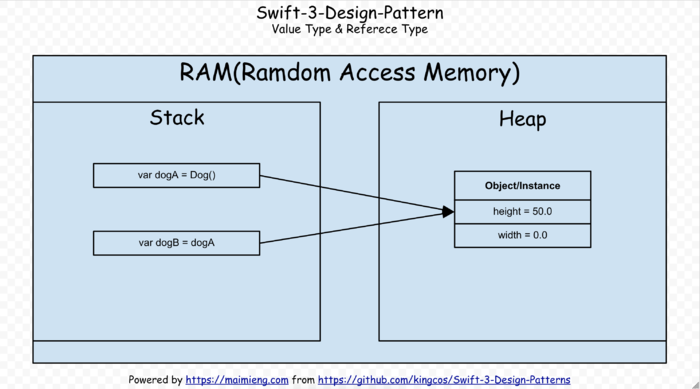
值类型 & 引用类型
值类型(Value Type)
值类型,即每个实例保持一份数据拷贝。
在 Swift 中,典型的有 struct,enum,以及 tuple 都是值类型。而平时使用的 Int, Double,Float,String,Array,Dictionary,Set 其实都是用结构体实现的,也是值类型。
Swift 中,值类型的赋值为深拷贝(Deep Copy),值语义(Value Semantics)即新对象和源对象是独立的,当改变新对象的属性,源对象不会受到影响,反之同理。
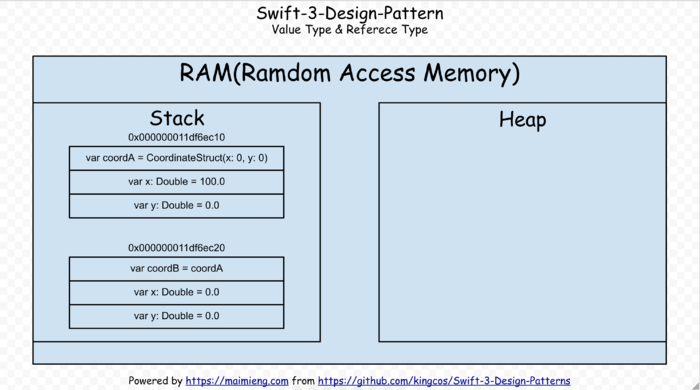
struct CoordinateStruct {
var x: Double
var y: Double
}
var coordA = CoordinateStruct(x: 0, y: 0)
var coordB = coordA
coordA.x = 100.0
print("coordA.x -> \(coordA.x)")
print("coordB.x -> \(coordB.x)")
// coordA.x -> 100.0
// coordB.x -> 0.0
如果声明一个值类型的常量,那么就意味着该常量是不可变的(无论内部数据为 var/let)。
let coordC = CoordinateStruct(x: 0, y: 0)
// WRONG: coordC.x = 100.0
在 Swift 3.0 中,可以使用
withUnsafePointer(to:_:)函数来打印值类型变量的内存地址,这样就能看出两个变量的内存地址并不相同。
withUnsafePointer(to: &coordA) { print("\($0)") }
withUnsafePointer(to: &coordB) { print("\($0)") }
// 0x000000011df6ec10
// 0x000000011df6ec20
在 Swift 中,双等号(== & !=)可以用来比较变量存储的内容是否一致,如果要让我们的 struct 类型支持该符号,则必须遵守 Equatable 协议。
extension CoordinateStruct: Equatable {
static func ==(left: CoordinateStruct, right: CoordinateStruct) -> Bool {
return (left.x == right.x && left.y == right.y)
}
}
if coordA != coordB {
print("coordA != coordB")
}
// coordA != coordB
引用类型(Reference Type)
引用类型,即所有实例共享一份数据拷贝。
在 Swift 中,class 和闭包是引用类型。引用类型的赋值是浅拷贝(Shallow Copy),引用语义(Reference Semantics)即新对象和源对象的变量名不同,但其引用(指向的内存空间)是一样的,因此当使用新对象操作其内部数据时,源对象的内部数据也会受到影响。
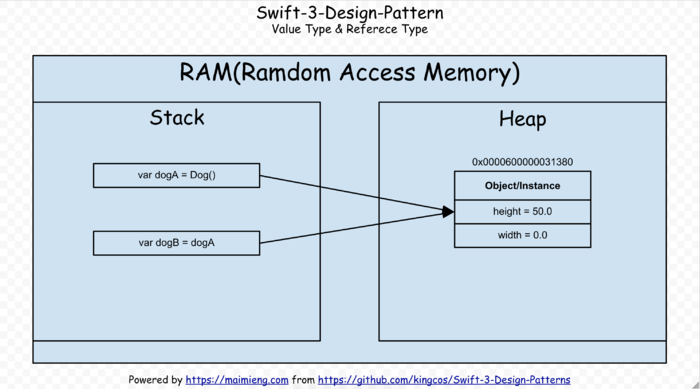
class Dog {
var height = 0.0
var weight = 0.0
}
var dogA = Dog()
var dogB = dogA
dogA.height = 50.0
print("dogA.height -> \(dogA.height)")
print("dogB.height -> \(dogB.height)")
// dogA.height -> 50.0
// dogB.height -> 50.0
如果声明一个引用类型的常量,那么就意味着该常量的引用不能改变(即不能被同类型变量赋值),但指向的内存中所存储的变量是可以改变的。
let dogC = Dog()
dogC.height = 50
// WRONG: dogC = dogA
在 Swift 3.0 中,可以使用以下方法来打印引用类型变量指向的内存地址。从中即可发现,两个变量指向的是同一块内存空间。
print(Unmanaged.passUnretained(dogA).toOpaque())
print(Unmanaged.passUnretained(dogB).toOpaque())
// 0x0000600000031380
// 0x0000600000031380
在 Swift 中,三等号(=== & !==)可以用来比较引用类型的引用(即指向的内存地址)是否一致。也可以在遵守 Equatable 协议后,使用双等号(== & !=)用来比较变量的内容是否一致。
if (dogA === dogB) {
print("dogA === dogB")
}
// dogA === dogB
if dogC !== dogA {
print("dogC !== dogA")
}
// dogC !== dogA
extension Animal: Equatable {
static func ==(left: Animal, right: Animal) -> Bool {
return (left.height == right.height && left.weight == right.weight)
}
}
if dogC == dogA {
print("dogC == dogA")
}
// dogC == dogA
参数 与 inout
预备
定义一个 ResolutionStruct 结构体,以及一个 ResolutionClass 类。这里为了方便打印对象属性,ResolutionClass 类遵从了 CustomStringConvertible 协议。
struct ResolutionStruct {
var height = 0.0
var width = 0.0
}
class ResolutionClass: CustomStringConvertible {
var height = 0.0
var width = 0.0
var description: String {
return "ResolutionClass(height: \(height), width: \(width))"
}
}
函数传参
在 Swift 中,函数的参数默认为常量,即在函数体内只能访问参数,而不能修改参数值。具体来说:
- 值类型作为参数传入时,函数体内部不能修改其值
- 引用类型作为参数传入时,函数体内部不能修改其指向的内存地址,但是可以修改其内部的变量值
func test(sct: ResolutionStruct) {
// WRONG: sct.height = 1080
var sct = sct
sct.height = 1080
}
func test(clss: ResolutionClass) {
// WRONG: clss = ResolutionClass()
clss.height = 1080
var clss = clss
clss = ResolutionClass()
clss.height = 1440
}
但是如果要改变参数值或引用,那么就可以在函数体内部直接声明同名变量,并把原有变量赋值于新变量,那么这个新的变量就可以更改其值或引用。那么在函数参数的作用域和生命周期是什么呢?我们来测试一下,定义两个函数,目的为交换内部的 height 和 width。
值类型
func swap(resSct: ResolutionStruct) -> ResolutionStruct {
var resSct = resSct
withUnsafePointer(to: &resSct) { print("During calling: \($0)") }
let temp = resSct.height
resSct.height = resSct.width
resSct.width = temp
return resSct
}
var iPhone4ResoStruct = ResolutionStruct(height: 960, width: 640)
print(iPhone4ResoStruct)
withUnsafePointer(to: &iPhone4ResoStruct) { print("Before calling: \($0)") }
print(swap(resSct: iPhone4ResoStruct))
print(iPhone4ResoStruct)
withUnsafePointer(to: &iPhone4ResoStruct) { print("After calling: \($0)") }
// ResolutionStruct(height: 960.0, width: 640.0)
// Before calling: 0x00000001138d6f50
// During calling: 0x00007fff5a512148
// ResolutionStruct(height: 640.0, width: 960.0)
// ResolutionStruct(height: 960.0, width: 640.0)
// After calling: 0x00000001138d6f50
小结:在调用函数前后,外界变量值并没有因为函数内对参数的修改而发生变化,而且函数体内参数的内存地址与外界不同。因此:当值类型的变量作为参数被传入函数时,相当于创建了新的常量并初始化为传入的变量值,该参数的作用域及生命周期仅存在于函数体内。
func swap(resCls: ResolutionClass) {
print("During calling: \(Unmanaged.passUnretained(resCls).toOpaque())")
let temp = resCls.height
resCls.height = resCls.width
resCls.width = temp
}
let iPhone5ResoClss = ResolutionClass()
iPhone5ResoClss.height = 1136
iPhone5ResoClss.width = 640
print(iPhone5ResoClss)
print("Before calling: \(Unmanaged.passUnretained(iPhone5ResoClss).toOpaque())")
swap(resCls: iPhone5ResoClss)
print(iPhone5ResoClss)
print("After calling: \(Unmanaged.passUnretained(iPhone5ResoClss).toOpaque())")
// ResolutionClass(height: 1136.0, width: 640.0)
// Before calling: 0x00006000000220e0
// During calling: 0x00006000000220e0
// ResolutionClass(height: 640.0, width: 1136.0)
// After calling: 0x00006000000220e0
小结:在调用函数前后,外界变量值随函数内对参数的修改而发生变化,而且函数体内参数的内存地址与外界一致。因此:当引用类型的变量作为参数被传入函数时,相当于创建了新的常量并初始化为传入的变量引用,当函数体内操作参数指向的数据,函数体外也受到了影响。
inout
inout 是 Swift 中的关键字,可以放置于参数类型前,冒号之后。使用 inout 之后,函数体内部可以直接更改参数值,而且改变会保留。
func swap(resSct: inout ResolutionStruct) {
withUnsafePointer(to: &resSct) { print("During calling: \($0)") }
let temp = resSct.height
resSct.height = resSct.width
resSct.width = temp
}
var iPhone6ResoStruct = ResolutionStruct(height: 1334, width: 750)
print(iPhone6ResoStruct)
withUnsafePointer(to: &iPhone6ResoStruct) { print("Before calling: \($0)") }
swap(resSct: &iPhone6ResoStruct)
print(iPhone6ResoStruct)
withUnsafePointer(to: &iPhone6ResoStruct) { print("After calling: \($0)") }
// ResolutionStruct(height: 1334.0, width: 750.0)
// Before calling: 0x000000011ce62f50
// During calling: 0x000000011ce62f50
// ResolutionStruct(height: 750.0, width: 1334.0)
// After calling: 0x000000011ce62f50
小结:值类型变量作为参数传入函数,外界和函数参数的内存地址一致,函数内对参数的更改得到了保留。
引用类型也可以使用 inout 参数,但意义不大。
func swap(clss: inout ResolutionClass) {
print("During calling: \(Unmanaged.passUnretained(clss).toOpaque())")
let temp = clss.height
clss.height = clss.width
clss.width = temp
}
var iPhone7PlusResClss = ResolutionClass()
iPhone7PlusResClss.height = 1080
iPhone7PlusResClss.width = 1920
print(iPhone7PlusResClss)
print("Before calling: \(Unmanaged.passUnretained(iPhone7PlusResClss).toOpaque())")
swap(clss: &iPhone7PlusResClss)
print(iPhone7PlusResClss)
print("After calling: \(Unmanaged.passUnretained(iPhone7PlusResClss).toOpaque())")
// ResolutionClass(height: 1080.0, width: 1920.0)
// Before calling: 0x000060000003e580
// During calling: 0x000060000003e580
// ResolutionClass(height: 1920.0, width: 1080.0)
// After calling: 0x000060000003e580
需要注意的是:
- 使用
inout关键字的函数,在调用时需要在该参数前加上&符号 -
inout参数在传入时必须为变量,不能为常量或字面量(literal) -
inout参数不能有默认值,不能为可变参数 -
inout参数不等同于函数返回值,是一种使参数的作用域超出函数体的方式 - 多个
inout参数不能同时传入同一个变量,因为拷入拷出的顺序不定,那么最终值也不能确定
struct Point {
var x = 0.0
var y = 0.0
}
struct Rectangle {
var width = 0.0
var height = 0.0
var origin = Point()
var center: Point {
get {
print("center GETTER call")
return Point(x: origin.x + width / 2,
y: origin.y + height / 2)
}
set {
print("center SETTER call")
origin.x = newValue.x - width / 2
origin.y = newValue.y - height / 2
}
}
func reset(center: inout Point) {
center.x = 0.0
center.y = 0.0
}
}
var rect = Rectangle(width: 100, height: 100, origin: Point(x: -100, y: -100))
print(rect.center)
rect.reset(center: &rect.center)
print(rect.center)
// center GETTER call
// Point(x: -50.0, y: -50.0)
// center GETTER call
// center SETTER call
// center GETTER call
// Point(x: 0.0, y: 0.0)
inout 参数的传递过程:
- 当函数被调用时,参数值被拷贝
- 在函数体内,被拷贝的参数修改
- 函数返回时,被拷贝的参数值被赋值给原有的变量
官方称这个行为为:copy-in copy-out 或 call by value result。我们可以使用 KVO 或计算属性来跟踪这一过程,这里以计算属性为例。排除在调用函数之前与之后的 center GETTER call,从中可以发现:参数值先被获取到(setter 被调用),接着被设值(setter 被调用)。
根据 inout 参数的传递过程,可以得知:inout 参数的本质与引用类型的传参并不是同一回事。inout 参数打破了其生命周期,是一个可变浅拷贝。在 Swift 3.0 中,也彻底摒除了在逃逸闭包(Escape Closure)中被捕获。苹果官方也有如下的说明:
As an optimization, when the argument is a value stored at a physical address in memory, the same memory location is used both inside and outside the function body. The optimized behavior is known as call by reference; it satisfies all of the requirements of the copy-in copy-out model while removing the overhead of copying. Write your code using the model given by copy-in copy-out, without depending on the call-by-reference optimization, so that it behaves correctly with or without the optimization.
作为一种优化,当参数是一个存储于内存中实际地址的值时,函数体内外共用相同的一块内存地址。该优化行为被称作通过引用调用;其满足 copy-in copy-out 模型的所有必需条件,同时消除了拷贝时的开销。不依赖于通过引用调用的优化,使用 copy-in copy-out 提供的模型来写代码,以便在进不进行优化时(都能)正确运行。
嵌套类型
在实际使用中,其实值类型和引用类型并不是孤立的,有时值类型里会存在引用类型的变量,反之亦然。这里简要介绍这四种嵌套类型。
值类型嵌套值类型
值类型嵌套值类型时,赋值时创建了新的变量,两者是独立的,嵌套的值类型变量也会创建新的变量,这两者也是独立的。
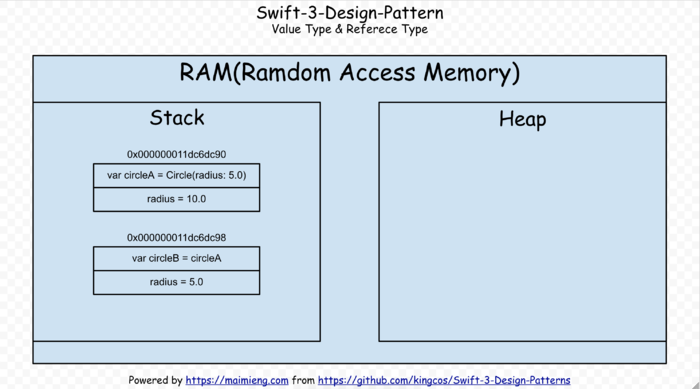
struct Circle {
var radius: Double
}
var circleA = Circle(radius: 5.0)
var circleB = circleA
circleA.radius = 10
print(circleA)
print(circleB)
withUnsafePointer(to: &circleA) { print("circleA: \($0)") }
withUnsafePointer(to: &circleB) { print("circleB: \($0)") }
withUnsafePointer(to: &circleA.radius) { print("circleA.radius: \($0)") }
withUnsafePointer(to: &circleB.radius) { print("circleB.radius: \($0)") }
// Circle(radius: 10.0)
// Circle(radius: 5.0)
// circleA: 0x000000011dc6dc90
// circleB: 0x000000011dc6dc98
// circleA.radius: 0x000000011dc6dc90
// circleB.radius: 0x000000011dc6dc98
值类型嵌套引用类型
值类型嵌套引用类型时,赋值时创建了新的变量,两者是独立的,但嵌套的引用类型指向的是同一块内存空间,当改变值类型内部嵌套的引用类型变量值时(除了重新初始化),其他对象的该属性也会随之改变。
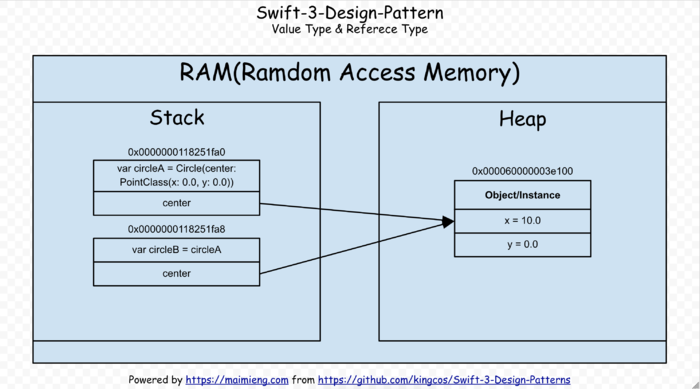
class PointClass: CustomStringConvertible {
var x: Double
var y: Double
var description: String {
return "(\(x), \(y))"
}
init(x: Double, y: Double) {
self.x = x
self.y = y
}
}
struct Circle {
var center: PointClass
}
var circleA = Circle(center: PointClass(x: 0.0, y: 0.0))
var circleB = circleA
circleA.center.x = 10.0
print(circleA)
print(circleB)
withUnsafePointer(to: &circleA) { print("circleA: \($0)") }
withUnsafePointer(to: &circleB) { print("circleB: \($0)") }
print("circleA.center: \(Unmanaged.passUnretained(circleA.center).toOpaque())")
print("circleB.center: \(Unmanaged.passUnretained(circleB.center).toOpaque())")
// Circle(center: (10.0, 0.0))
// Circle(center: (10.0, 0.0))
// circleA: 0x0000000118251fa0
// circleB: 0x0000000118251fa8
// circleA.center: 0x000060000003e100
// circleB.center: 0x000060000003e100
引用类型嵌套值类型
引用类型嵌套值类型时,赋值时创建了新的变量,但是新变量和源变量指向同一块内存,因此改变源变量的内部值,会影响到其他变量的值。
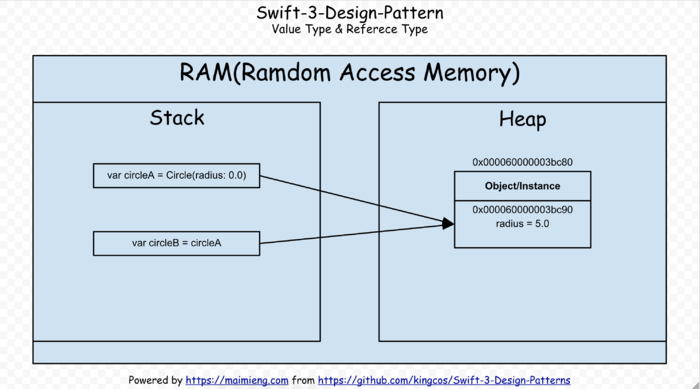
class Circle: CustomStringConvertible {
var radius: Double
var description: String {
return "Radius:\(radius)"
}
init(radius: Double) {
self.radius = radius
}
}
var circleA = Circle(radius: 0.0)
var circleB = circleA
circleA.radius = 5.0
print(circleA)
print(circleB)
print("circleA: \(Unmanaged.passUnretained(circleA).toOpaque())")
print("circleB: \(Unmanaged.passUnretained(circleB).toOpaque())")
withUnsafePointer(to: &circleA.radius) { print("circleA.radius: \($0)") }
withUnsafePointer(to: &circleB.radius) { print("circleB.radius: \($0)") }
// Radius:5.0
// Radius:5.0
// circleA: 0x000060000003bc80
// circleB: 0x000060000003bc80
// circleA.radius: 0x000060000003bc90
// circleB.radius: 0x000060000003bc90
引用类型嵌套引用类型
引用类型嵌套引用类型时,赋值时创建了新的变量,但是新变量和源变量指向同一块内存,内部引用类型变量也指向同一块内存地址,改变引用类型嵌套的引用类型的值,也会影响到其他变量的值。
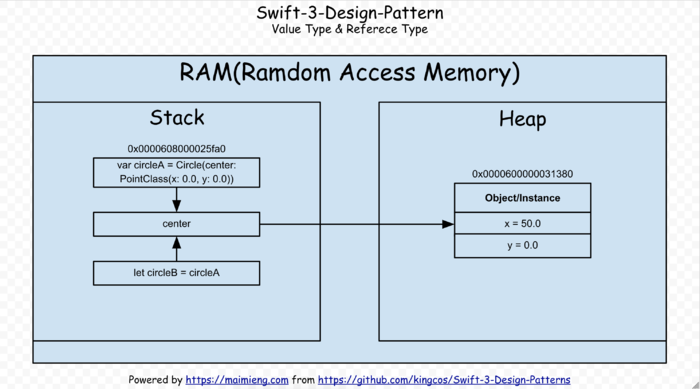
class PointClass: CustomStringConvertible {
var x: Double
var y: Double
init(x: Double, y: Double) {
self.x = x
self.y = y
}
var description: String {
return "(\(x), \(y))"
}
}
class Circle: CustomStringConvertible {
var center: PointClass
var description: String {
return "Center:\(center)"
}
init(center: PointClass) {
self.center = center
}
}
var circleA = Circle(center: PointClass(x: 0.0, y: 0.0))
let circleB = circleA
circleA.center.x = 5.0
print(circleA)
print(circleB)
print("circleA: \(Unmanaged.passUnretained(circleA).toOpaque())")
print("circleB: \(Unmanaged.passUnretained(circleB).toOpaque())")
print("circleA.center: \(Unmanaged.passUnretained(circleA.center).toOpaque())")
print("circleB.center: \(Unmanaged.passUnretained(circleB.center).toOpaque())")
// Center:(5.0, 0.0)
// Center:(5.0, 0.0)
// circleA: 0x0000608000025fa0
// circleB: 0x0000608000025fa0
// circleA.center: 0x0000608000025820
// circleB.center: 0x0000608000025820
总结
这篇文章是我在着手写 Swift 中的 struct & class & enum 一文时抽离出来的一篇。主要还是围绕了值类型中的 struct 和引用类型中的 class,在本文 stack & heap 一节中,只是简单描述,因为一直对此部分内容感到迷惑,也查阅很多资料,希望最近可以总结出来一篇小文,与大家分享。
When|值类型 Value Type|引用类型 Reference Type
-----|-----|-----|-----
1|== 有意义时|=== 有意义时
2|独立|共享,可变
3|在多线程使用的数据|-
在本文的叙述中,可能有许多说法与您平时所用的术语略有差池,例如变量指向的内存空间,其实也等价于变量指向的内存地址。在行文过程中,查阅了很多国外的资料,也尽力将语言规范,以免产生歧义,如果有任何错误或建议,您都可以在评论中直接提出,我会研究学习,虚心接受,并作出相应整改。




